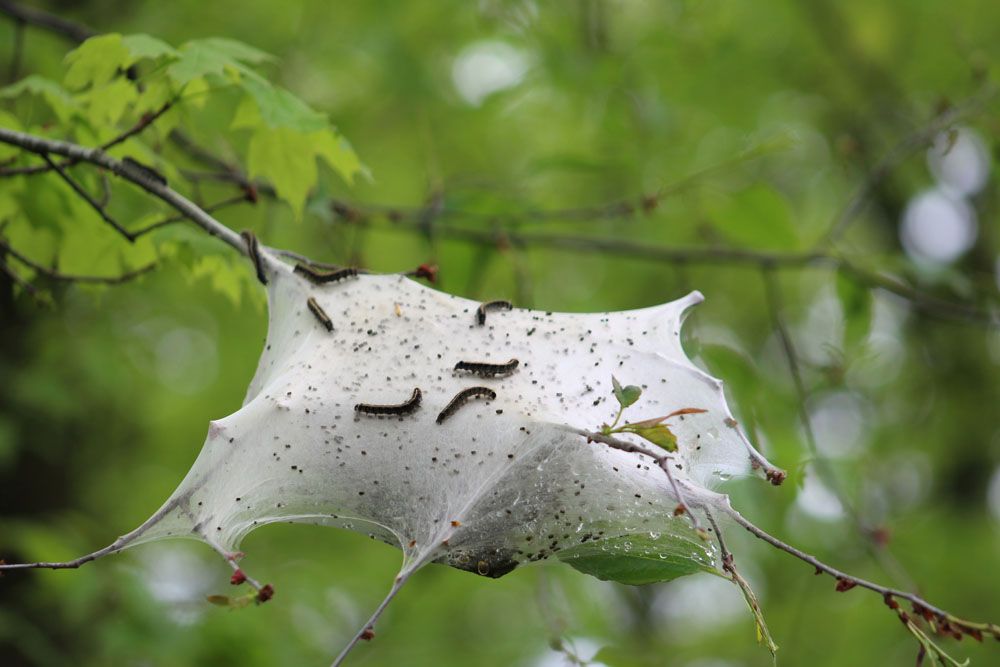
Tent Caterpillars – Fall Webworms
Tent caterpillars and fall webworms
In our area, we have two web-spinning caterpillars: the eastern tent caterpillar and the fall webworm. The position of the webbing on the tree will aid in determining which caterpillar is present.
Description of Tent Caterpillars:
Larvae are around 2″ long when fully mature, with scant hairs. They are black with white and blue patterns and a white line down the center of the back. Adult moths are reddish-brown with two white lines that run obliquely across each forewing. The keys to eradicating tent caterpillars include early and precise identification, knowing their life cycle, and employing suitable cultural or chemical management methods.
Description Fall Webworm:
Larvae are around 1 1/2 inches long when fully developed “lengthy they might be bright with dark stripes and dots, or a drab blue black with no yellow. Their bodies are covered with hair, and their heads are black. Adult moths have wingspan of 1 1/2 inches “… Their hue is almost entirely white.
The life cycle of Tent Caterpillar:
The Eastern tent caterpillar has one generation every year. The insects spend the winter as egg masses on twigs, hatching in April. Larvae build their tent after two days of eating. As the larvae grow, more layers are added to the tent. The larvae build cocoons, pupate, and emerge as adults in early June. Females lay a large number of eggs in bands around twigs. The larvae grow inside the eggs but do not hatch until the following spring.
Life Cycle of Fall Webworm:
The Eastern tent caterpillar has one generation every year. The insects spend the winter as egg masses on twigs, hatching in April. Larvae build their tent after two days of eating. As the larvae grow, more layers are added to the tent. The larvae build cocoons, pupate, and emerge as adults in early June. Females lay a large number of eggs in bands around twigs. The larvae grow inside the eggs but do not hatch until the following spring.
What kind of damage is caused by tent caterpillars?
Tent caterpillars feed on a variety of broadleaf trees and shrubs, creating ugly webs or tents. Caterpillars, when in high numbers, can defoliate trees, limiting their growth. They wreak havoc on ornamental and fruit plants. Forest tent caterpillars may cause damage to other surrounding plants when they defoliate target trees. Vegetables, fruit trees, and other tiny fruits, as well as nursery crops, have been damaged. They are an annoyance when encountered near buildings or on roadways.
What kind of damage is caused by fall webworm?
The fall webworm, Hyphantria cunea (Drury), is a pest of various ornamental trees and shrubs and a variety of crops. Larvae feed in massive nests and can defoliate trees and shrubs.
Control:
The maintenance of both pests is roughly the same. Destroying the tents, especially while they are tiny, is an efficient method of removing the caterpillars. When the larvae are in the tent, the optimum time is around dark or early morning. The tents should not be burned since the fire, and high heat may harm the tree. Egg masses on lesser trees can be trimmed off and killed. A spray may be required for bigger trees or trees with several nests. These caterpillars are resistant to Bacillus thuringiensis (Bt) and a variety of chemical pesticides. If an insecticide is used, it should be used while the larvae are tiny and easy to manage, rather than when they are fully developed and have already done their harm. When the insects are in the nest, apply the pesticide in the evening or early morning. To get the insecticide into the tents, a high-pressure spray may be required. Always keep in mind to read and follow label instructions for safe pesticide use!
